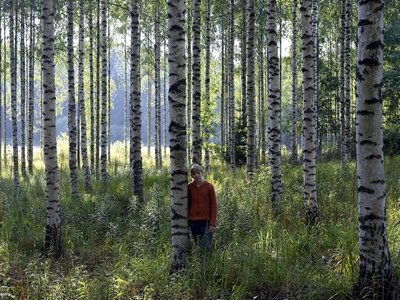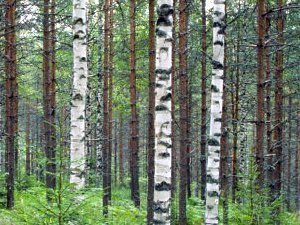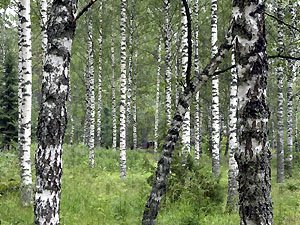
Fig. 1: Birch stand on the lakeshore. (All photos: Erkki Oksanen/Metla)
Silviculture of Silver Birch in Finland
Birch is the most important broad-leaved tree in Finland. There are two commercially important birch species: downy birch (Betula pubescens Ehrh.) and silver birch (Betula pendula Roth). The proportion of birch in Finland's forest resources (volume of growing stock) is 16% or 363 million m3. Although downy birch is more common (12%), silver birch (4%) is more economically valuable.
Two-thirds of Finland's birch resources grow in mixed forests dominated by conifers. In addition, silver birch is also planted and managed as pure stands. The proportion of planted silver birch stands in artificially regenerated forests was about 5% between 2000 and 2010. Birch is an important tree species for both chemical and mechanical forestry. Downy birch is mainly used for pulp, but silver birch is a valuable raw material for the mechanical woodworking industry. A slender trunk, moderate branching and light wood are valuable characteristics of silver birch.
Ecology
Birches are typical light-demanding, shade-intolerant pioneer species that readily occupy open areas after forest fires and clearcuts. Birches have rapid early growth. In managed birch stands, growth is vigorous up to an age of 40‑50 years. Vitality declines before the age of 100 and susceptibility to decay and other defects increases. Birch can only maintain vitality and vigorous growth if it is the dominant tree in a stand with relatively wide spacing and low levels of intra-stand competition.
The most suitable growing sites for silver birch are fertile forest sites types, and afforested abandoned fields. The most important site characteristics for vigorous growth of silver birch are adequate moisture and air content. The best forest sites for silver birch are sandy and silty moraine soils and fine sandy soils. Clay and silty soils are often too compact for silver birch, which also suffers from flooding. The site requirements of downy birch are not as strict as those of silver birch. It can survive also on compact soils and on wet peatlands.
Management of silver birch
Silver birch can be grown either in pure stands or in mixed stands together with the conifers. In both cases, the management objective is to produce high quality sawn timber or plywood. The aim of silver birch silviculture is to produce large diameter, straight and defect free logs.
Management of pure stands

Fig. 2: High quality silver birch stand.
Planting with genetically improved seedlings is the main method of artificial regeneration of silver birch. As a result of an intensive birch breeding program in Finland, the yield and stem quality of silver birch has been significantly improved. Large-scale production of genetically improved birch seed in polythene greenhouse seed orchards, has become an established and profitable practice.
As a shade intolerant tree species, silver birch crown development and tree growth are retarded when planted at high densities. Therefore, relatively wide initial spacing and intensive thinning are required in order to ensure a high yield of good quality timber at final felling and adequate removal of merchantable timber during thinning.
Container-grown seedlings will be used for planting at a density of 1600 seedlings/ha, which has been found to be the maximum number of silver birch trees per hectare that can reach merchantable stem size. Therefore, no pre-commercial thinning is usually required in birch plantations, but weed control is recommended, especially on the most fertile sites.
When managing silver birch stands, the rule of thumb is that the proportion of live crown should be at least 50% of the tree height for vigorous growth. Thinning accelerates stem diameter growth and sawtimber yield, shortens the rotation, and thus increases harvesting revenue. In silver birch stands, rapid diameter growth does not affect the quality of the timber, which can be the case in coniferous stands. In addition, a shorter rotation reduces the risk of decay, which is a typical defect of old birch stands.
The typical management plan for a planted silver birch stand includes two commercial thinnings during the rotation. The first commercial thinning is usually done at the dominant height of 13-15 m to a density of 700 trees per hectare. At this time, the stems of the dominant silver birch are free of live branches along the length of the butt log. Thinning is mainly for pulpwood or energy wood. Timing and careful harvesting are important in birch thinning, as the growth of young birch trees is highly sensitive to stand density, and birch stems can be severely damaged by careless harvesting.
The second commercial thinning usually takes place about 15 years after the first thinning. The number of stems after thinning is about 350 to 400 trees per hectare. In the second thinning, some sawtimber is removed in addition to pulpwood.
The typical rotation in silver birch plantations varies between 40 and 60 years, depending on the productivity of the site and the quality of the growing stock. In stands where high quality sawtimber can be produced, rotations tend to be longer than in lower quality birch stands.
Due to self-pruning, silver birch stems are usually free of live branches up to a height of 5-7 meters, i.e. along the butt log length, at the time of the first commercial thinning. Therefore, high pruning of birch stems is not always necessary to produce high quality sawn timber. However, if the goal is to ensure top quality timber production, pruning is recommended and should be initiated as part of young stand management practices. Pruning is recommended in two phases. The first pruning takes place at the height of 6-7 meters up to the pruning height of 2.5-3 meters. The number of pruned trees is 600 - 700 stems per hectare. The second pruning takes place when the stand height exceeds 10 meters. Then it is recommended to prune 400 - 500 birch trees per hectare, with a pruning height of 5 - 6 meters. The final number of pruned trees at the time of final felling is about 350 trees per hectare. In pruned stands with top quality trees, longer rotations are used than in stands with average timber quality. When pruning birch, it is recommended to use pruning shears instead of pruning saws to avoid bark and trunk damage. The risk of damage is low if the diameter of the pruned branches is less than 2 cm and the work is done carefully. Birch trees should be pruned during the growing season in July or well before the growing season in late winter or early spring.
Fertilization is not a common practice in birch management. The few results from empirical fertilization trials suggest that fertilization of silver birch is not profitable due to weak growth response.
Management of mixed stands

Fig. 3: Pine-birch mixtures can only be found on good site for pine.

Fig. 4: Curly birch stand.
In mixed stands dominated by Scots pine or Norway spruce, the dominant birch is able to maintain its vitality throughout the commercial rotation period. Furthermore, the stem quality of silver birch is often better in mixed stands than in pure birch plantations.
On fertile mineral soils, silver birch and Norway spruce are the most common species mixtures in commercial stands. Both species have fairly similar site requirements and are both productive. The different growth patterns and shade tolerance of silver birch and Norway spruce reduce competition between the species. The growth of silver birch begins to decline at a time when the growth rate of Norway spruce has not yet reached its peak. As a shade-tolerant species, Norway spruce does not suffer too much from the shade of the birch mixture and can even survive in the understorey.
The typical sites for Scots pine are too poor for silver birch. However, mixtures of silver birch and Scots pine can be found on the best sites for pine. As both species are shade intolerant, competition between pine and birch is stronger than between birch and spruce. However, with intensive silviculture, silver birch and Scots pine can be grown successfully in a mixed stand.
A small birch mixture in a spruce-dominated mixed stand can even slightly increase the total yield compared to a pure spruce stand. A small birch mixture in a pine-dominated stand has a negligible effect on yield. However, a high proportion of birch in a mixed stand has been found to result in reduced timber production compared to pure conifer stands. Silver birch requires wide spacing and heavy thinnings to maintain its vitality. Heavy thinnings in turn result in lower wood production during the rotation.
Successful management of an even-aged mixed birch-conifer stand requires skilful and intensive silviculture due to the different growth patterns of the tree species. As a fast-growing pioneer species, birch tends to outcompete conifers in a seedling stand. Therefore, conifer seedlings should be planted earlier than birch seedlings. In practice, the difference in tree age between conifers and birches should be 5 to 10 years in naturally regenerated stands. In spruce plantations where site preparation has been carried out, naturally regenerated birches that emerge on the site after planting will not out-compete planted spruces and can later be grown in the same tree layer together with spruces.
Stands where fast-growing birches have already out-competed spruce seedlings can easily develop into two-storey stands with birch above and spruce below. With intensive management and careful felling, it is possible to grow the birch overstory to sawtimber size and harvest it without causing too much damage to the spruce understory. Once the birch overstorey has been felled, the stand is managed as a single-storey spruce stand.
Management of curly birch

Fig. 5: Curly birch wood.
European silver birch (Betula pendula var. carelica (Mercklin) Hämet-Ahti) is a variety of silver birch. Based on the appearance of the trunk, a distinction is made between curly grain with protrusions, necks, rings and stripes. Mixed types may also occur. Typical features of curly grained wood include irregular cell orientation, wider than normal wood rays and ingrown bark, resulting in a brown flamy pattern.
Curly grained wood is particularly valuable and is sold by the kilo rather than the cubic metre. With a fresh wood density of over 900 kg/m3 and a current (2008) price for curly grained logs (3-5 €/kg), the price of a cubic metre can easily exceed 3000 €. However, prices can vary considerably depending on the quality of the curly grain, the length and diameter of the logs and the size of the consignment. Even good quality curly grained knots are in demand. Small or bushy forms of curly birch not suitable for timber production can be used as ornamental trees in gardens and parks.
The establishment of a curly birch stand is similar to that of a silver birch stand. Repeated thinnings are necessary to ensure sufficient light (more than for silver birch). Final felling takes place at the age of 40-50 years. Artificial pruning of the stems should preferably be started two to three years after planting and then continued in stages. July has proved to be the best time for pruning.
Silver birch – the national tree species of Finland
Besides wood production, birch is an important species from the point of view of non-wood products and services. Birches are important to the biodiversity of northern coniferous forests. A large number of species live together with birches, including mycorrhiza forming fungi, herbivores, wood decaying fungi and saproxylic insects. Finally, silver birch is the national tree species of Finland with a great importance to the Finnish culture and landscape. Light green birch stand at the lakeshore in the early summer is one of the most famous Finnish landscapes.

